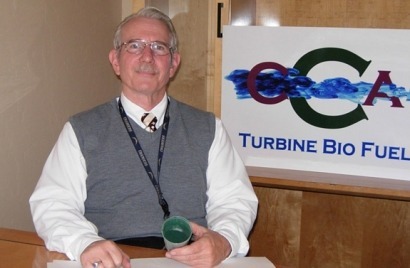
Compact Contractors for America (CCA), a Southern Utah-based company, has developed a dry process biofuel from algae, camelina seed, and other non-fossil fuel sources. Dry process biofuels are essentially powders that can be fluidized and combusted in jet turbine engines, and have been around for a long time, at least since the first pulverized coal power plants. What CCA has done is identify the most effective feedstock’s, process methodology and fuel delivery processes to make dry process biofuels scalable to military operations. Consequently, CCA claims that its Turbine Bio Fuel is the “future of modern flight”. Interview date: December, 2010 Interviewer: Toby Price Could you provide a brief description of how your powdered biofuel is produced? Algae is harvested and fed directly into a Spray Dryer for processing into a powdered fuel. Much the same process as is used to produce powdered milk or vegetable supplements. Why does your product lend itself so well to being used as aviation fuel? The use of powdered coal as a fuel for turbine began with the German military in the mid 1940’s when they were deprived of oil from the Poleski Oil fields. In the US research on coal during the early 1980’s, in many forms, began in earnest. I drew upon that prior research. Penn State University was a leader in that research. I was fortunate enough to make contact with the Applied Research Lab and its director, Dr. Tom Cawley. They have a powdered fuel delivery system that is currently in use for several studies. You have the same name as Robert Fulton – a descendent of yours credited with turning the steamboat into a commercial success. Do you envisage your biofuel could also be used in the shipping industry or in other transport sectors? Yes, it could be used successfully in place of liquid fuels for turbine use. At this time, we do not see the fuel being used in internal combustion engines. There is considerable debate surrounding whether or not algae-based biofuels are environmentally sustainable. How confident are you that sufficient algae feedstock could be produced in a sustainable manner to have a true impact on the aviation industries impact on the environment and why? Our process is agnostic in its execution. We can produce a variety of fuel grades based upon the feedstock available. Nuisance algae is abundant in the US and elsewhere. High lipid content algae is currently being used for waste water remediation, providing an ongoing source for processing of high grades fuels. With algae of some kind growing most everywhere, we are faced with requiring an elaborate production facility to grow algae for our use. In this regard, have you analysed the carbon balance of the algae cultivation and processing process, as well as the subsequent combustion of your biofuel to identify its true carbon footprint? One of the issues with ramping up use of other renewable fuels such as hydrogen is the lack of an established storage and distribution infrastructure. Would this be a problem with your biofuel? Does the fact it is in powder form mean new systems would have to be developed to store and transport your biofuel? You recently closed a deal with United States Air Force Research Laboratory to supply it with your biofuel. Where does CAA go from here? Do you have any other customers lined up and how far away do you think CAA is from commercialisation? Several commercial airlines such as Japan Airlines and Chile’s Sky Airlines have turned their attention to algae-based biofuels. Why have you decided to focus on the military use of your fuel, and do you envisage algal aviation fuels will be become an industry standard? If so, within what timeframe? Finally, what support do you need now from the US government and private investors to reach commercialisation? Through our relationship with Southern Utah University, CCA has received “bootstrap” research and commercialization funding from the State of Utah through its USTAR initiative. USTAR has also connected CCA with algae research efforts at Utah State University. Overall, however, the government, like most large industries, is slow to adopt new technologies. Inertia is the primary cause. The solution is straightforward, demonstrable at the large scale. The US government and other governments around the world have invested in biomass research huge sums of money. Like all research, some in profitable, some is interesting, but yields no real benefits, and some were a waste of money. Currently, powdered fuel is a quandary for most investors and government agencies. Their “crystal ball” is cloudy. It is up to CCA and its developers to rigorously pursue funding. It is incumbent upon us to assiduously use that funding to prove commercial viability and more importantly, profitability of Turbine Bio Fuel. For additional information:

